It has been busy, busy, busy at Seaview what with elections, visitors, – and a film crew! A certain film company read my blogs on our beach treasure collections and our local seaside walk and thought we might fit into the storyline they were working on. So one blissfully hot Sunday in May, we had an invasion … They snapped up our view ….
They snapped up our view …. While we laid out our curious beachy collections ….
While we laid out our curious beachy collections ….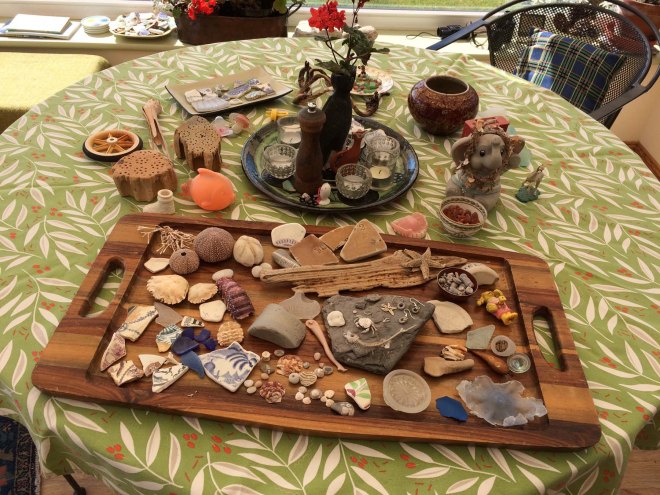 In preparation for this visit, I had tidied up our brick collection (as you do) ….
In preparation for this visit, I had tidied up our brick collection (as you do) ….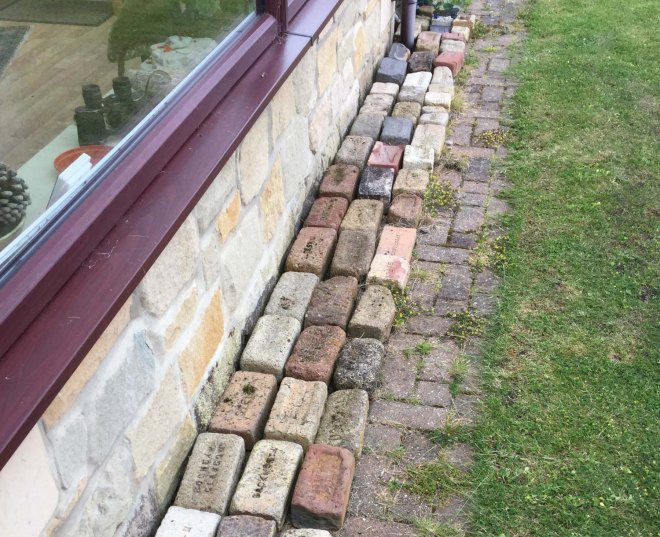 And since I mentioned our brick-collecting in Sanquhar in my last blogpost, I thought I would continue here with more of our brick story.
And since I mentioned our brick-collecting in Sanquhar in my last blogpost, I thought I would continue here with more of our brick story.
We started collecting bricks the first winter we were here. Over that icy first winter of 2010/11, our walks regularly took us to the spit (the sand mound between the river and the sea at Spittal Point). At this time the spit was a long protruding neck of sand running along the Tweed opposite Berwick. There were all sorts of treasures washed up on these shifting sands, midway between the river Tweed and the open North Sea.
There were all sorts of treasures washed up on these shifting sands, midway between the river Tweed and the open North Sea. Among them were bricks …
Among them were bricks … According to one local we spoke to, workmen demolishing buildings in Berwick’s Marygate to make way for the bus station (now in its turn demolished) threw the old bricks into the river Tweed. Gradually these bricks are being washed up onto the local beaches.
According to one local we spoke to, workmen demolishing buildings in Berwick’s Marygate to make way for the bus station (now in its turn demolished) threw the old bricks into the river Tweed. Gradually these bricks are being washed up onto the local beaches.
I say gradually because that first winter we found a lot of bricks. Then the sands of the spit shifted, moulded by storms and floods and wind and weather, and our brick-collecting almost stopped. For a long while we found very few bricks on the beach. Now I’m delighted to report the bricks are back again!
Back to that first winter: we would regularly carry a brick back each from the beach – if not two. What has really defined our brick-collecting is the writing on the bricks. They all tell a story.
Let’s take Niddrie as an example. The Niddrie brick works was on the south-east of Edinburgh. Founded in the 1920s to accommodate the expansion in house building, the brickworks were demolished in 1991. If you’ve ever visited the Fort Kinnaird retail park, you’ve visited the site of the Niddrie brickworks! I love Niddrie bricks – this one is warmly golden and we know they were solidly made because we often find them undamaged.
The Niddrie brick works was on the south-east of Edinburgh. Founded in the 1920s to accommodate the expansion in house building, the brickworks were demolished in 1991. If you’ve ever visited the Fort Kinnaird retail park, you’ve visited the site of the Niddrie brickworks! I love Niddrie bricks – this one is warmly golden and we know they were solidly made because we often find them undamaged. Other bricks from other places. Glenboig, Castlecary and Boghead Glasgow all hail from areas round Glasgow. Backworth is a Durham brick, and like many brickworks adjoined the local colliery. A ready supply of fuel and waste from the mining often supplied the perfect materials for the brick making.
Other bricks from other places. Glenboig, Castlecary and Boghead Glasgow all hail from areas round Glasgow. Backworth is a Durham brick, and like many brickworks adjoined the local colliery. A ready supply of fuel and waste from the mining often supplied the perfect materials for the brick making.
A couple of Castlecary bricks in this collection below indicate the variety of brick that might have been produced from a single brickworks. The Sandysike brick below comes from an area north of Carlisle. This is an area that has a history of brick making dating back to Roman times.
The Sandysike brick below comes from an area north of Carlisle. This is an area that has a history of brick making dating back to Roman times. Our interest in these local bricks has inspired enthusiasm in other family members. It’s not unusual for us to send a car back to the Westcountry laden with Dougall bricks. You betray your age here: the young fondly remember Father Ted, and I hark back to The Magic Roundabout. Either way, this has nothing to with the real history of the Dougall brickworks. They were made at Bonnybridge, north-east of Glasgow, from 1896 to 1967.
Our interest in these local bricks has inspired enthusiasm in other family members. It’s not unusual for us to send a car back to the Westcountry laden with Dougall bricks. You betray your age here: the young fondly remember Father Ted, and I hark back to The Magic Roundabout. Either way, this has nothing to with the real history of the Dougall brickworks. They were made at Bonnybridge, north-east of Glasgow, from 1896 to 1967. In turn our Westcountry family has supplied us with some nice bricks. St Day hails from a Redruth brickworks.
In turn our Westcountry family has supplied us with some nice bricks. St Day hails from a Redruth brickworks.  And I particularly like these old tiles designed to protect electricity cables which were also a gift from the Westcountry.
And I particularly like these old tiles designed to protect electricity cables which were also a gift from the Westcountry. Of particular relevance to Berwick with its history as a long-time grain exporter are these granary bricks. The holes in the bricks were designed to aerate the grain. I believe they were made at a Nuneaton brickworks, north of Coventry.
Of particular relevance to Berwick with its history as a long-time grain exporter are these granary bricks. The holes in the bricks were designed to aerate the grain. I believe they were made at a Nuneaton brickworks, north of Coventry. Some are superior to others. Compare the glazed brick here (reminding me so much of Victorian jelly moulds!) with the rough-cast granary brick below. The added patina of green mound is from sitting in damp parts of our garden.
Some are superior to others. Compare the glazed brick here (reminding me so much of Victorian jelly moulds!) with the rough-cast granary brick below. The added patina of green mound is from sitting in damp parts of our garden.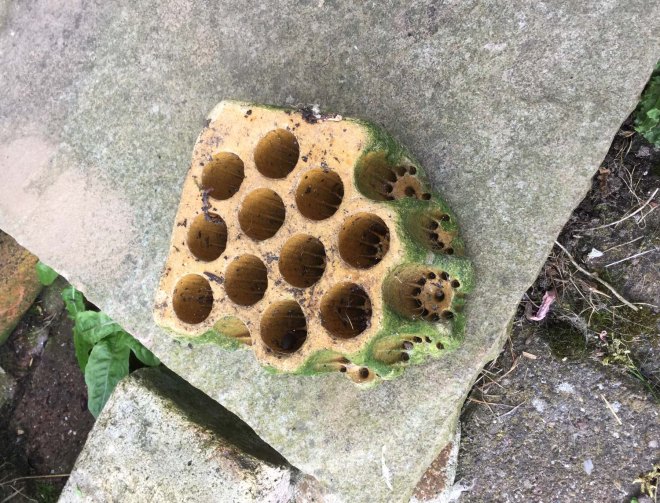
 I am deeply indebted to several knowledgeable and brick-loving websites for all the historic information which I have linked to, and I have listed my sources at the end of this blog. I guess those writers and researchers, like me, are fascinated by industrial archaeology and the ordinary stories of human labour and habitation tied up with brick manufacture.
I am deeply indebted to several knowledgeable and brick-loving websites for all the historic information which I have linked to, and I have listed my sources at the end of this blog. I guess those writers and researchers, like me, are fascinated by industrial archaeology and the ordinary stories of human labour and habitation tied up with brick manufacture.
For me the pleasure in bricks also lies in the tones, shapes and colours of all the different bricks and how they marry up with the flowers in our garden. Poppies and forget-me-nots self seed in the gaps. A collection of bricks sits around Gary, our classy garden gnome, and the planter, here full of spring flowers …
A collection of bricks sits around Gary, our classy garden gnome, and the planter, here full of spring flowers …
 And here, later in the season, featuring poppies ….
And here, later in the season, featuring poppies …. The bricks come in handy about the house for all sorts of purposes.
The bricks come in handy about the house for all sorts of purposes. Actually, our present abundance of bricks makes me chuckle – when I lived in Devon I was always short of bricks! Some twenty years or so ago, I had a spell of making doorstops from half-bricks and would guard those few bricks I found jealously. You’ll recognise my language obsession here too. This doorstop is a pleasing play on Francis Thompson’s poem, The Kingdom of God: “Turn but a stone and start a wing.”
Actually, our present abundance of bricks makes me chuckle – when I lived in Devon I was always short of bricks! Some twenty years or so ago, I had a spell of making doorstops from half-bricks and would guard those few bricks I found jealously. You’ll recognise my language obsession here too. This doorstop is a pleasing play on Francis Thompson’s poem, The Kingdom of God: “Turn but a stone and start a wing.” And here, from the same poem: ‘Tis your estrangèd faces, That miss the many-splendored thing.”
And here, from the same poem: ‘Tis your estrangèd faces, That miss the many-splendored thing.” I don’t think these compressed lines from Dylan Thomas’s poem Fern Hill perhaps work so well here (I’ve used too many colours): “Now as I was young and easy […] Prince of the apple towns […] Time let me play and be golden […] in his mercy.”
I don’t think these compressed lines from Dylan Thomas’s poem Fern Hill perhaps work so well here (I’ve used too many colours): “Now as I was young and easy […] Prince of the apple towns […] Time let me play and be golden […] in his mercy.”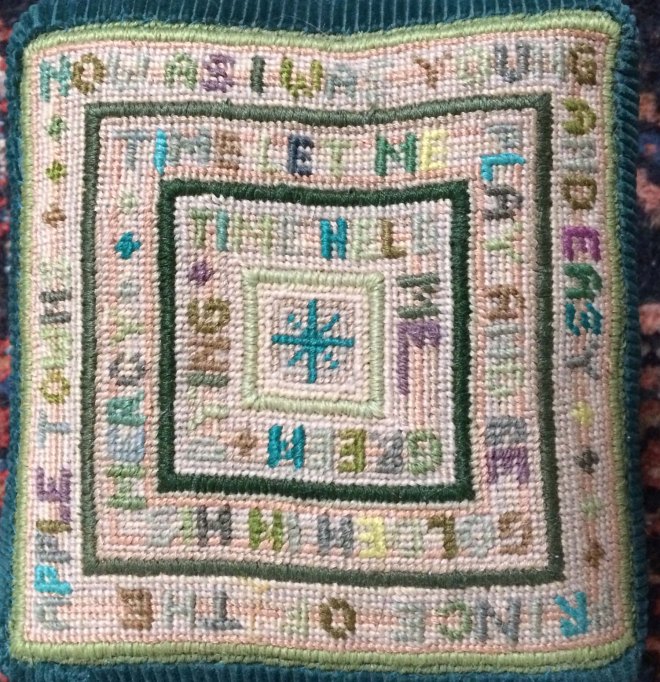 There are an odd few doorstops that are a bit wonky and without words.
There are an odd few doorstops that are a bit wonky and without words. Nowadays I find myself more drawn to bricks than ever. They stand out on an ordinary walk round the countryside
Nowadays I find myself more drawn to bricks than ever. They stand out on an ordinary walk round the countryside 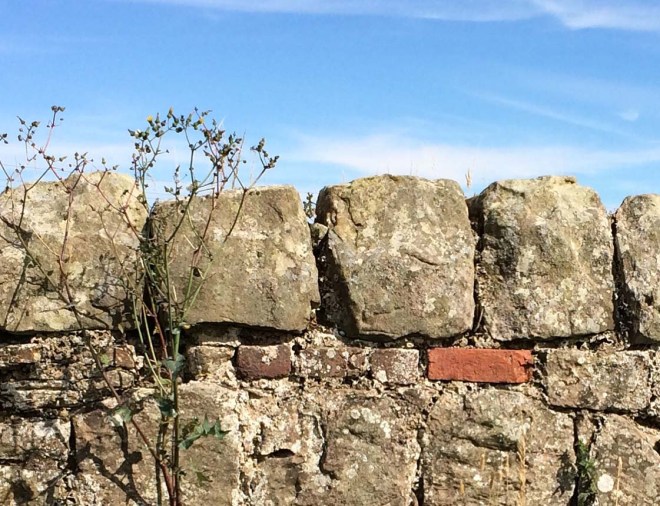 … or a nearby village ….
… or a nearby village …. We were delighted to find this wonderful brick sculpture by Julia Hilton in the beautiful and mysterious boggy gardens at Paxton House. Her sculpture, aptly called Entrances, is made of old bricks from the Armadale brickworks.
We were delighted to find this wonderful brick sculpture by Julia Hilton in the beautiful and mysterious boggy gardens at Paxton House. Her sculpture, aptly called Entrances, is made of old bricks from the Armadale brickworks. And a visit to the local builders’ merchant offers new unexpected delights!!
And a visit to the local builders’ merchant offers new unexpected delights!! As to that film crew – well, we’re still waiting to hear too ….
As to that film crew – well, we’re still waiting to hear too ….
I have drawn on these excellent internet sources for historic information on brick making:

I do love your posts – they are so rich with content and imagery and photos. Thank you!
LikeLike
Thank you so much, Frith. I know I’m rather a slow blogger, and tend to produce long blogposts, but my stories (once started) seem to have a life of their own, and go on …. and on …. and on!
LikeLike
Did you take a sample brick?
I’m drawn towards items like fabric, wool, pottery, stone, etc and want to touch it all. Bricks are fascinating to me, especially when they are worn. It’s like they have a tale to tell. A few years back I saw one of my favourite pieces in the ECA degree show by Alex Allan – he’d collected bricks from the Water of Leith and built a kiln out of them then used driftwood to represent water https://images.theskinny.co.uk/assets/production/7909/7909_large.jpg.
LikeLike
No, Laura! No sample brick – plenty enough here!! Thank you so much for sending that wonderful Alex Allan pic – what a great installation! I completely agree with you about the texture of natural materials and the yen to feel them as well as see them. Don’t you love it when you go to an exhibition and they invite you to touch?
LikeLike
Haha … I can’t believe you resisted a free brick, although I do guess it would be a little out of keeping with the others.
Touchy feely exhibitions are heaven 😍
LikeLiked by 1 person
I wonder if anyone will treasure the modern day bricks in quite the same way. Your collection is fascinating – bricks are all around us but we rarely take time to appreciate them. Interesting about the link between the brickworks and collieries.
We too have a collection of bricks as every time a building is altered or taken down we have to laboriously clean every brick and store it away on pallets for … who knows, one day they’ll come in useful.
LikeLike
I hope people will continue to treasure bricks, Anne – after all, they are still often the basic item in building material terms. Nice to hear that you save your old bricks – what fun it would be to build anew with those that were once your pigsty or cowshed etc – in fact, that’s what everybody who visits us teases with:”When are you going to build something with these bricks?!”
LikeLike
What fun! And how nice to have the background on your brick mania – which is more extensive than I realised! I love the doorstops.
LikeLike
It’s brick mania, is it, Polly?!!! Yes, well put really. 🙂 I think it is in large part – as Little Lolly Travels says above – a passion for natural textures. Funnily enough, I’d forgotten I made doorstops until I started to write this blog, and I am wondering if I might make some more ……
LikeLike
J & D > Of course this is a fascinatingly informative and well-illustrated post and we’re so glad the significance your collection – and your detailed knowledge – has been recoginized by others. We quite understand about bricks! Now we have a special reason to thank you for this piece, which we’ll come to in a moment. There’s not much in the way of brick, here in Uist – not even in modern houses (mostly concrete block, rendered), and of course older houses are made of stone. But here at the walled garden we do find a lot of bricks buried in the ground or incorporated into the wall. The latter, in particular, suggest that the bricks are very old – even if used for repairs (which in many cases looks to be improbable) they’d be 150yrs plus old. They are hand-made bricks, and would have been imported from mainland somewhere (but there are no distinguishing marks to identify a possible source). Why were they brought here? Many questions are raised in thought: and even more mysterious were the strange perforated clay tiles we’ve found in a certain part of the garden. Or rather, mysterious until now … when we discover from you that they are granary tiles. This will set us off trying to reinterpret the strange and conflicting features of that part of the garden, and perhaps we may end up being able to post something about this … thanks to you both!
LikeLike
Thank you very much for your kind words – but all credit is due entirely to the knowledgeable folk whose websites I’ve referred to in this blog. Lots of other people collect stuff on the beach – it was only because I’ve written it up for my blog that the film company picked it up….. We are both so fascinated to hear about your own bricks, and delighted that you’ve now managed to identify your granary bricks. They are lovely, aren’t they? I’ve emailed you separately with further information you might like to follow up – Happy Brick Collecting!
LikeLiked by 1 person
That is so exciting you are going to be a part of the film – make sure to let us know when it’s live – I am sure it will be something worth watching! As for the bricks, I love their texture and color and have a soft spot for brick walls. One day I would love to have a stone/brick pathway in the garden with the grass growing between the edges 🙂
LikeLike
Yes, it was very exciting and very fascinating to be filmed, Alina – but I wouldn’t be at all surprised if they cut the 4 hours filming down to 2 minutes!! So we are trying not to get too excited about it. That pathway you dream about sounds lovely 🙂
LikeLike
What a great collection! Totally identify with your interest in them. And bloody hell, Gary’s still around, looking out on Holy Island of all places! Do they brew Fosters lager there? The village I come from in the West Midlands (then Staffordshire) was famous for its blue bricks, though I have never gone into the history. Still have my beautiful covered brick and it’s in constant use. Love those false teeth on your finds table … you can only wonder at the scenario that led to their loss!
LikeLike
Thank you, Mandy – and yes, Gary is going very strong, especially considering he is out in all weathers!! He is one very classy gnome. I didn’t know that about the West Midland blue bricks – next time you visit Martin …….!
LikeLike